
Residents dying alone.
There will be no opportunity for politicians to say ‘we didn’t know’.
In the lead up to the federal election ANMF is ramping up its national campaign calling on politicians to legislate aged care nurse and carer to resident ratios in private-for-profit and not-for-profit aged care.
Some federal Victorian senators and candidates have already pledged their support. You can see if your politician or candidate supports ratios on our national campaign page at goo.gl/WRgeRZ
If your local member, senator or candidate is missing from the list send them an urgent email via our ‘Time for Ruby’ page at goo.gl/DEHdk1
A minimum number of nurses and carers will ensure safe, quality resident care.
The private-for-profit and not-for-profit aged care providers’ claims that they roster nurses and carers according to changing clinical needs are disingenuous.
Residents’ requirements are certainly greater for example than one registered nurse, one enrolled nurse and six personal care workers overnight for 165 residents living in a six-storey building.
That’s one registered nurse responsible for 165 residents across multiple levels. This is a real ratio in Melbourne.
In a survey this year ANMF aged care members told us about understaffing’s unacceptable consequences on vulnerable people. Dying residents do not have the compassionate bedside care they deserve. Residents miss out on medication and wound care. Residents wait too long for pain care, assistance to go to the bathroom or for someone simply to move that cup of tea closer so they stay hydrated.
Many nurses and carers also told us they had been injured by an aggressive resident.
Aged care providers have a legal responsibility to ‘maintain an adequate number of appropriately skilled staff’. They receive taxpayer funding, with no strings attached, to employ those staff.
Despite the law and the funding there are not enough nurses or carers rostered on every shift to ‘ensure that the care needs of residents are met.’
Coinciding with systemic understaffing, the private-for-profit and not-for-profit residential aged care sector has started recording annual profits over one billion dollars. Something is not right.
Inadequate staff, poor resident outcomes and distressed families should not be the stories coming out of taxpayer-funded residential aged care. We know these are not the only stories and many are providing good care. But we do know there are not enough nurses or carers.
As Treasurer, the now Prime Minister Scott Morrison cut aged care funding by $1.2 billion to address suspicions some providers were over claiming on their funding applications based on residents’ needs.
In February, the government gave those same providers part of an additional $320 million ‘to help increase support’ – again, no strings attached. It’s meaningless because it will disappear.
It should have been better targeted and given to smaller aged care facilities particularly in regional and rural Australia.
We don’t need to wait for the aged care royal commission to tell us systemic understaffing is having a monumental impact on the care and dignity of vulnerable people living in nursing homes.




